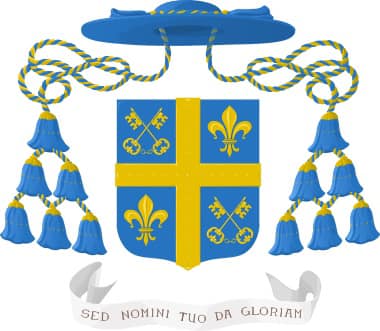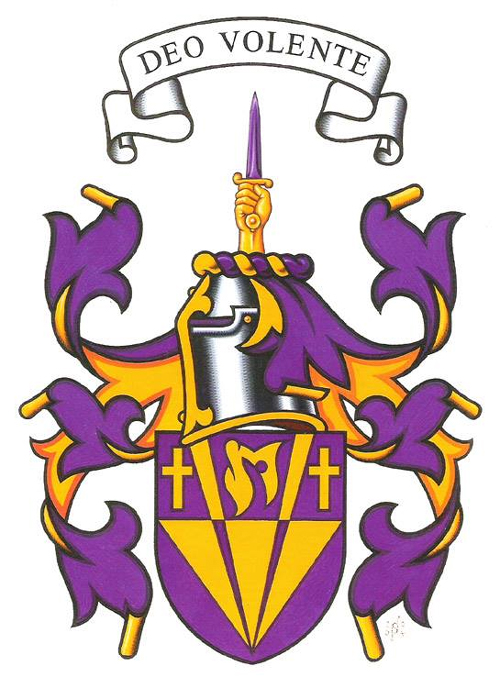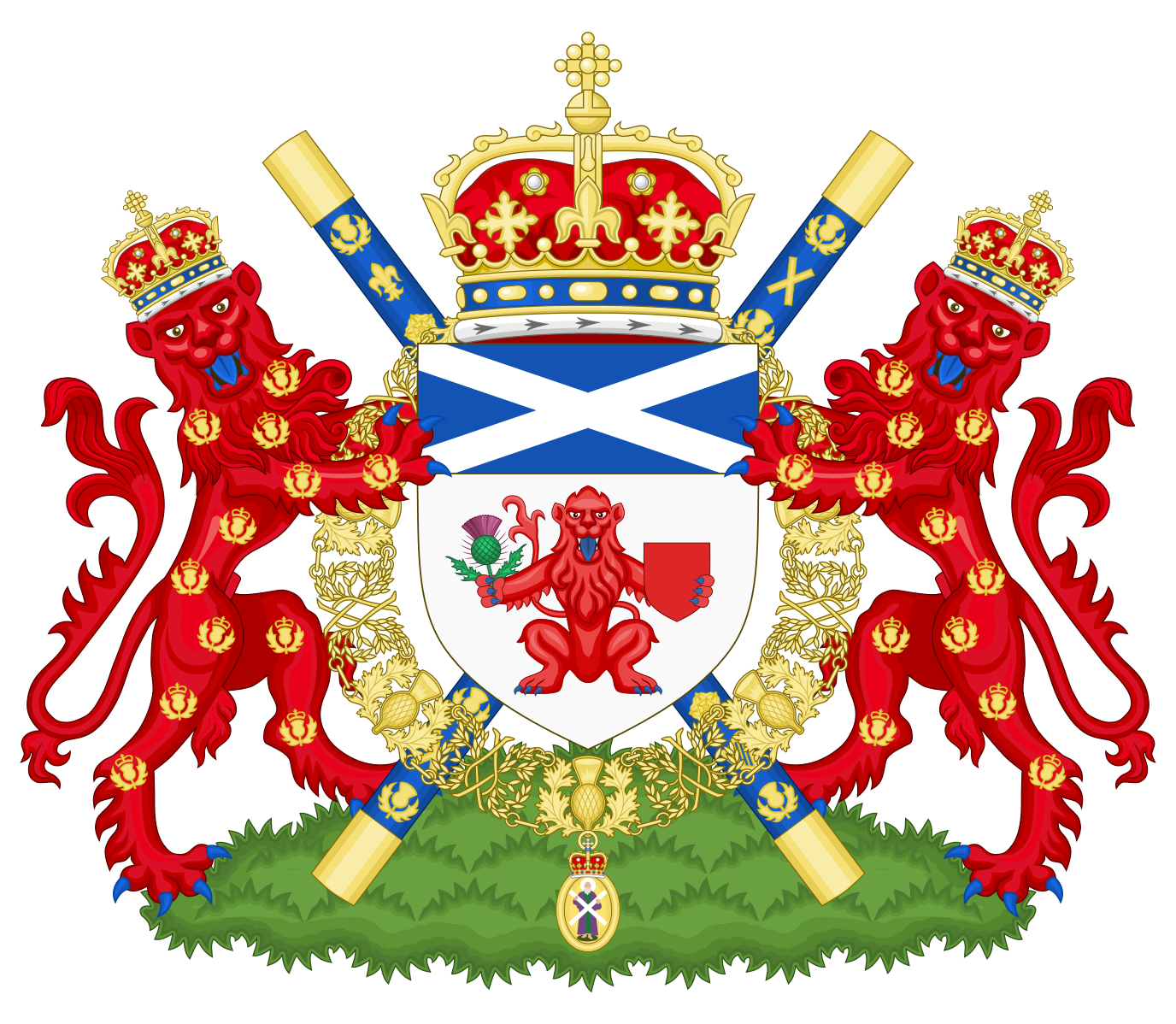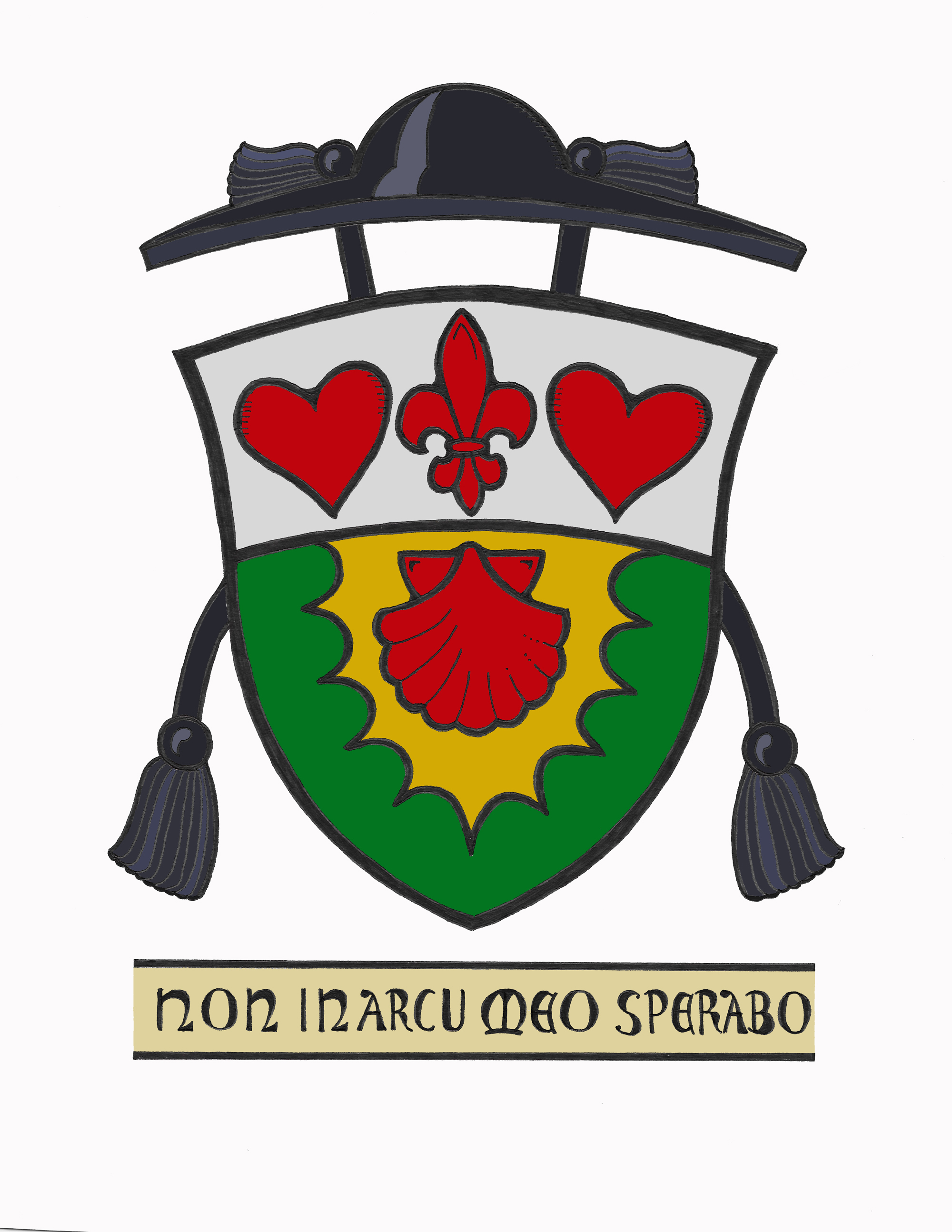Among the various ways that a parish community can record and mark its history is through the use of heraldry. Many are familiar with the custom of churches having incorporated into the architecture of the building, or in a church building’s decoration, the coat of arms of the reigning pope and the bishop at the time the church was constructed or consecrated. The use of the coats of arms of the pastors who have served the parish can be similarly used.
In a previous assignment where I served as Rector of a Shrine Church I entered into a project to devise what would be considered attributed arms for all of my predecessors so that the tenure of each Rector could be remembered by means of a coat of arms for each displayed in the Rectory Office. I was even able to devise a coat of arms for my successor as well!
I arrived at my current parish assignment as Parish Administrator, a common practice in many dioceses including my own. The idea is to have a new priest serve as Administrator (a temporary appointment) for a time until it is determined if the man is a “good fit” for the parish at which time, usually one year, he would be appointed Pastor with a six-year renewable term. In my case I served as Administrator for two years because as the end of my first year was approaching our bishop resigned and a new bishop arrived who wanted to take some time himself to settle in to the diocese before making any major decisions.
At the time my tenure as Administrator began I devised a coat of arms for the parish community. In June of this year I was appointed Pastor of the parish and my official Installation takes place later this month. To mark this start of a new chapter I decided to undertake a similar project of devising coats of arms for my predecessors to be displayed in a suitable place somewhere in one of the parish buildings.
There have been 23 priests in charge of St. Joseph Church, Washington, New Jersey since its establishment as an independent parish in 1871. Of those 23 one of them, Rev. John Eagan, served here for only 11 months in 1943 as Administrator. In addition, one of the priests, Rev. John Auchter, actually served here for six years but was never an incardinated priest of the Metuchen Diocese. Rather, he was and always remained, a priest of the neighboring diocese of Allentown, Pennsylvania on loan to the Metuchen Diocese. Consequently, he only had the title “Administrator” but was, for all intents and purposes, the Pastor of this parish as much as any of the others. So, while Fr. Eagan is not counted among the Pastors of St. Joseph Fr. Auchter is counted among their number. As a result I find myself now as the 22nd Pastor of St. Joseph.
For the purposes of this project I found it rather daunting to face the prospect of devising 21 attributed coats of arms. Therefore, I decided to try and pare down the list. But, what criteria should I use to do so. I decided to look at the entire history of the parish in stages. At its foundation in 1871, by Bishop James Roosevelt Bayley, the nephew of St. Elizabeth Ann (Bayley) Seton, the parish was part of the then Diocese of Newark which, at that time, covered the entire state of New Jersey. Just ten years later, in 1881, the parish became part of the newly established Diocese of Trenton encompassing eight counties in the central part of New Jersey. A century later St. John Paul II decided to separate the four northern counties of Trenton and erect the Diocese of Metuchen in November of 1981. Once again, the parish of St. Joseph found itself in a new diocese. It was this last separation, becoming part of the diocese in which it currently finds itself, that I decided to use as my dividing line. At least for the time being this project encompasses the coats of arms of the seven Pastors the parish has had since the erection of the Diocese of Metuchen. At some point in the future other coats of arms can be added until all the Pastors are represented.
Creating attributed arms is both a challenge and a lot of fun. All but two of my predecessors are deceased and the living ones could not be easily consulted. In addition, two of the seven who served here since 1981 are non-armigerous because, sadly, they both were convicted of crimes and sentenced to prison. As such, it is not appropriate to devise coats of arms for them and had they been armigerous the privilege of having a coat of arms would have been lost to them.
In each case the attributed arms contains charges that allude to their names or to some other strong association with them. That way, each is somewhat easily associated with the priest it represents. In all cases their personal arms are emblazoned impaled with the arms assumed for the parish itself and the shield is ensigned with a simple priest’s galero. No mottoes were used in the depiction of these achievements.

The Arms of St. Joseph Parish, Washington, New Jersey (est. 1871)
The arms are based on those of George Washington for whom the Borough and Township where the parish is located are named. His arms showed two red bars on a silver (white) field with three red stars above. Here the colors have been reversed and the stars changed to three fleurs-de-lis, a symbol of St. Joseph.

Rev. William Roos 16th Pastor 1979-1983
The name “Roos” alludes to a rose in Dutch, hence the three roses.

Rev. (later Monsignor) John A. Auchter (Administrator) 1983-1989
The lamp is from a German coat of arms associated with the family name. The chief contains the arms of the Diocese of Allentown, PA of which Fr. Auchter was an incardinated priest. After his time in New Jersey he returned to his own diocese and was later promoted to Prelate of Honor with the title “Rev. Monsignor”. However, when serving here he was still simply a priest.

Rev. Michael Santillo 18th Pastor 1989-1992
He does not have a personal coat of arms so the parish arms are impaled with a blank shield. The design on that half of the shield is a technique to fill empty space in heraldry called “diapering” and it is merely decorative.
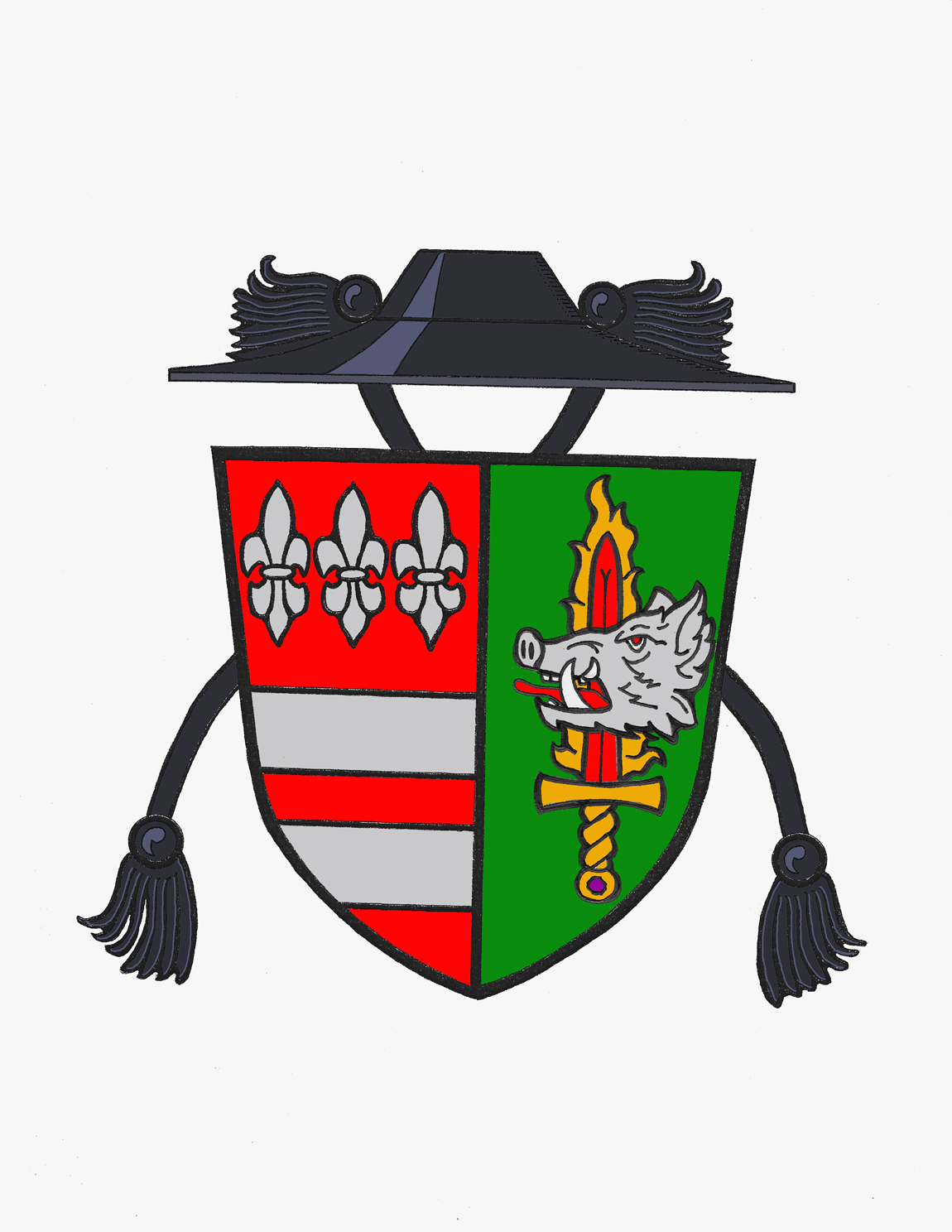
Rev. Michael A. Kochon 19th Pastor 1992-1999
Father Kochon’s arms consist of a flaming sword which is symbolic of his patron, St. Michael the Archangel and a wild hog’s head erased. In French the word cochon, similar to his surname Kochon, means pig so his personal arms allude to his given and family names.

Rev. (later Mr.) Robert J. Ascolese 20th Pastor 1999-2006
He does not have a personal coat of arms so the parish arms are impaled with a blank shield. The design on that half of the shield is a technique to fill empty space in heraldry called “diapering” and it is merely decorative.

Rev. Blaise R. Baran 21st Pastor 2006-2015
Father Baran’s name means “rain” in Persian, hence the raindrops. His patron, St. Blaise, is alluded to by the two candles crossed in saltire which are used to give the Blessing of Throats on the feast day of St. Blaise.
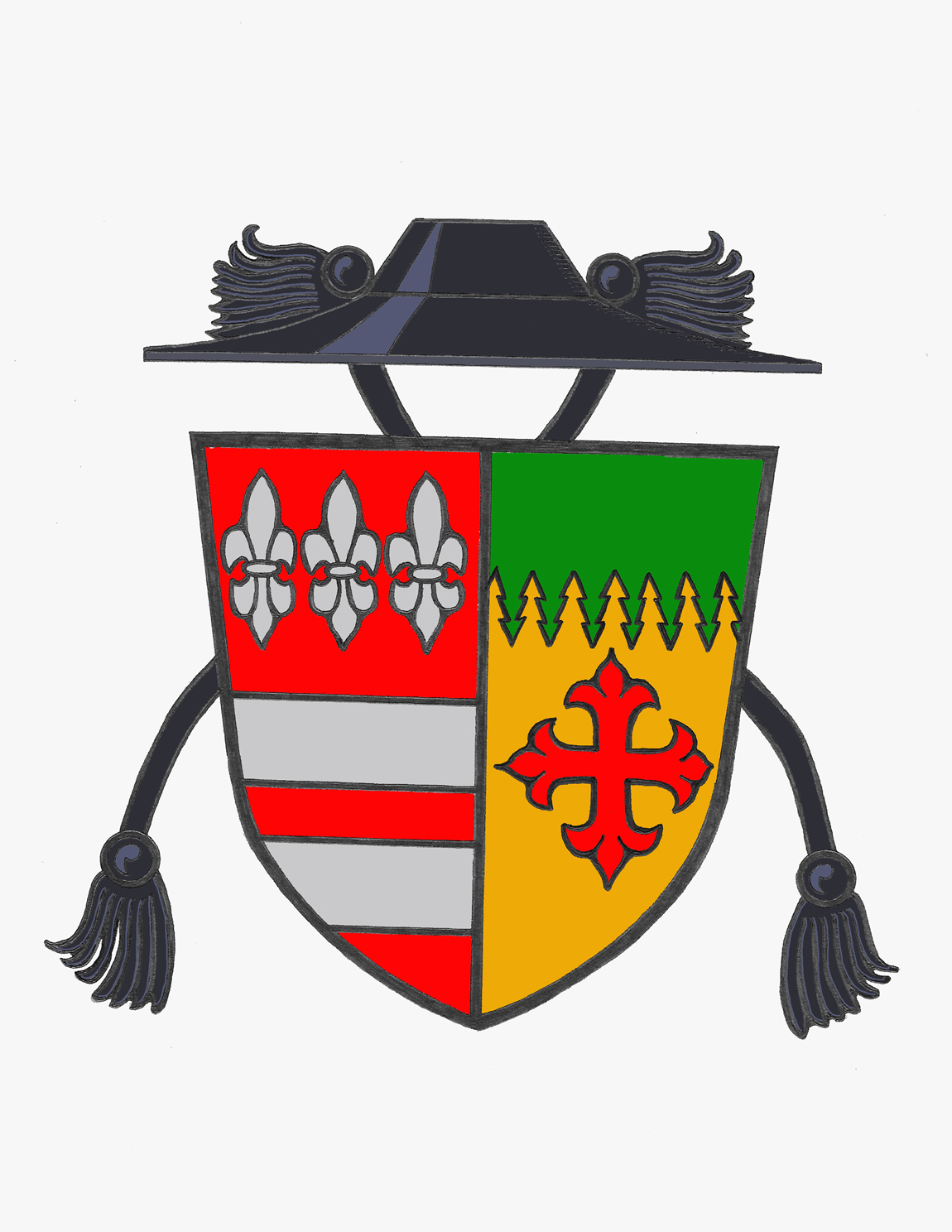
Rev. Guy W. Selvester (Administrator 2015-2017) 22nd Pastor 2017 –
Readers of this blog should know the symbolism of my arms by now but the division line sapiné (shaped like fir trees) alludes to my family name which was originally Silvestri (later anglicized to Selvester) which means a forest dweller or woodsman. The green and gold (yellow) tinctures are for my Irish ancestry and the cross for the centrality of my faith in my life. It is a cross fleury so that the fleurs-de-lis are references to both the Holy Trinity and Our Lady.







